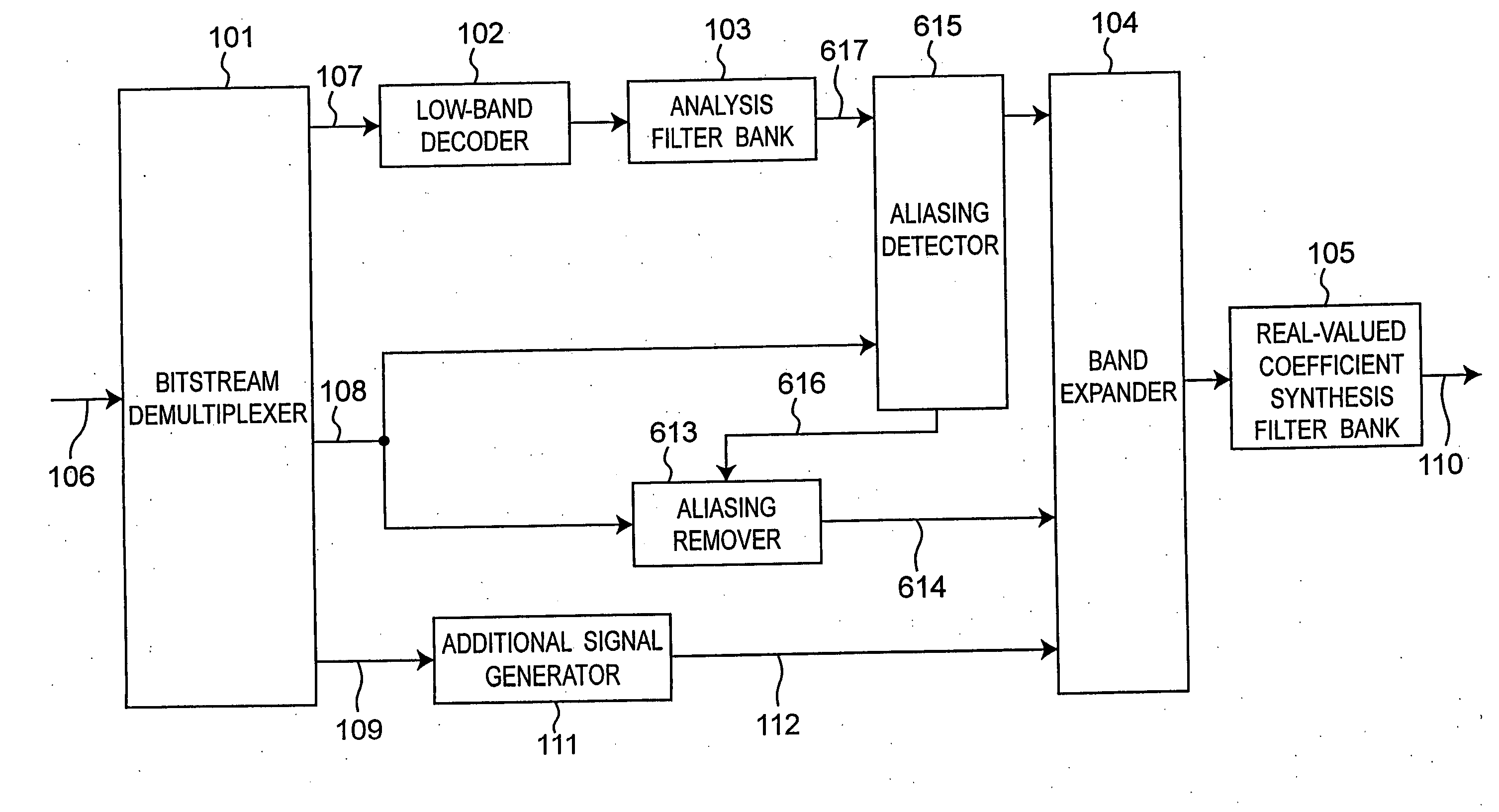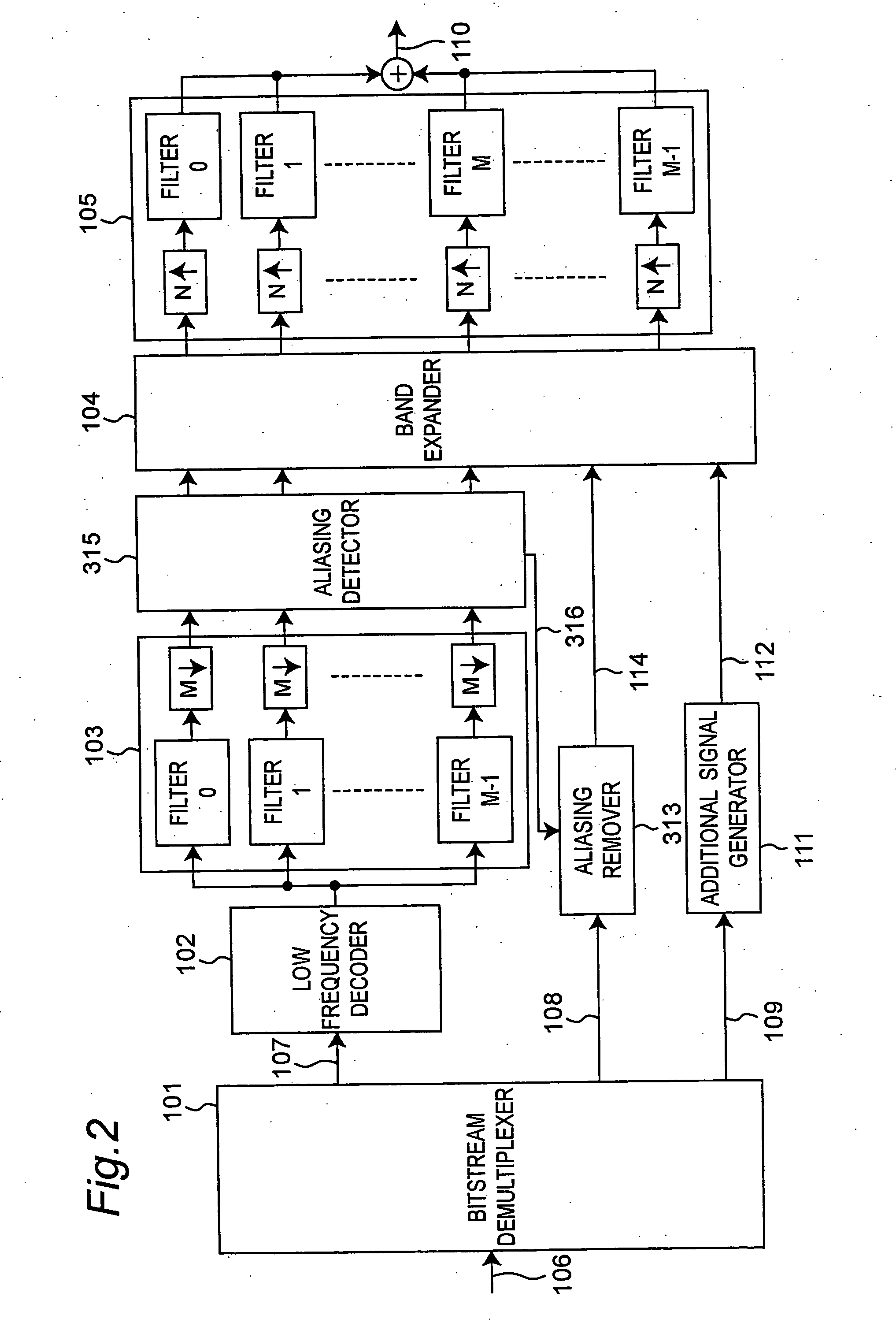Audio decoding apparatus and method
a bandwidth expansion and decoding technology, applied in the field of audio decoding apparatus and decoding method for audio bandwidth expansion system, can solve the problems of complex-valued synthesis filter bank that cannot be replaced by real-valued synthesis filter bank, power consumption increases, and audio degradation, etc., to suppress aliasing and suppress audio degradation
- Summary
- Abstract
- Description
- Claims
- Application Information
AI Technical Summary
Benefits of technology
Problems solved by technology
Method used
Image
Examples
embodiment 1
[0032]FIG. 1 is a schematic block diagram showing a decoding apparatus according to a first embodiment of the present invention.
[0033] This decoding apparatus has a bitstream demultiplexer 101, low frequency decoder 102, analysis filter bank 103, band expander (band expanding means) 104, synthesis filter bank 105, aliasing remover 113, and additional signal generator 111.
[0034] The bitstream demultiplexer 101 receives an input bitstream 106 and demultiplexes the bitstream 106 into low frequency component information 107, high frequency component information 108, and additional signal information 109. The low frequency component information 107 has been encoded using the MPEG-4 AAC coding method, for example. The low frequency decoder 102 decodes low frequency component information 107 and generates a time signal representing the low frequency component.
[0035] The resulting time signal representing the low frequency component is then divided into multiple (M) subbands by the analy...
embodiment 2
[0052]FIG. 2 is a schematic drawing of a decoding apparatus according to a second embodiment of the present invention. This embodiment differs from the configuration shown in FIG. 1 in the addition of an aliasing detection means (aliasing detector) 315 for detecting subbands where there is a high likelihood of aliasing components being introduced. The detection data 316 output from the aliasing detector 315 is input to aliasing remover 313 which then adjusts the gain of the high frequency components based on the detection data 316.
[0053] Operation of the decoding apparatus according to this second embodiment is the same as that of the first embodiment except for that relating to the aliasing detector 315 and aliasing remover 313. Only the operation of the aliasing detector 315 and aliasing remover 313 is therefore described below.
[0054] The operating principle of the aliasing detector 315 is described first.
[0055] Aliasing cannot logically be avoided insofar as real-valued subban...
embodiment 3
[0079] The aliasing detector 315 in the above second embodiment compares a predetermined threshold value with the reflection coefficients of each subband, and based on the relation between these values detects and outputs as a binary value whether aliasing occurs or not. When the evaluation value changes near the threshold value using a binary value detection method, the aliasing detection value for occurrence / non-occurrence changes frequently. This complicates tracking whether to adjust or not adjust gain, and can adversely affect sound quality.
[0080] The aliasing detector 315 in the present embodiment therefore detects the degree of occurrence of aliasing. That is, rather than using a binary value to simply indicate whether aliasing is detected or not, the occurrence of aliasing is indicated by a continuous value denoting the degree of occurrence of aliasing. Gain is then adjusted based on this continuous value to achieve a smooth transition. Sudden changes in gain caused by cha...
PUM
 Login to View More
Login to View More Abstract
Description
Claims
Application Information
 Login to View More
Login to View More - R&D
- Intellectual Property
- Life Sciences
- Materials
- Tech Scout
- Unparalleled Data Quality
- Higher Quality Content
- 60% Fewer Hallucinations
Browse by: Latest US Patents, China's latest patents, Technical Efficacy Thesaurus, Application Domain, Technology Topic, Popular Technical Reports.
© 2025 PatSnap. All rights reserved.Legal|Privacy policy|Modern Slavery Act Transparency Statement|Sitemap|About US| Contact US: help@patsnap.com



